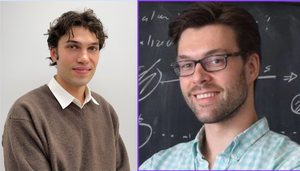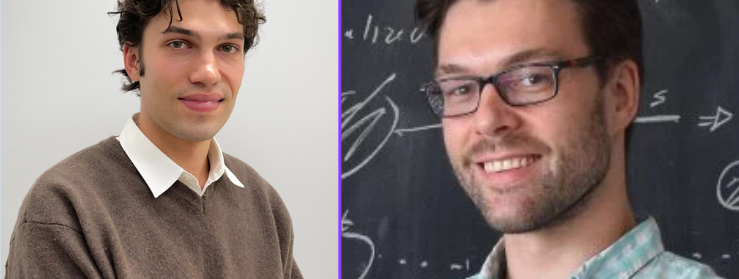"Dissipative Dark Substructure: The Consequences of Atomic Dark Matter on Milky Way Analog Subhalos" published in November 2023 in arXivLabs.
Authors: Caleb Gemmell, Sandip Roy, Xuejian Shen, David Curtin, Mariangela Lisanti, Norman Murray, Philip F. Hopkins

The research analyses simulations of galaxies that contain a subcomponent of atomic dark matter. The aim of this study is to compare the behaviour of galaxies containing only cold dark matter (the standard cosmological assumption) and galaxies with both cold dark matter and a small amount of atomic dark matter. Atomic dark matter differs from cold dark matter because it can lose energy and cool like the hydrogen gas found in our galaxy, compared to cold dark matter that only interacts gravitationally. We look at how atomic dark matter may change the properties of the nearby satellite galaxies, as well as the distribution and orbits of the dark matter only subhalos.
Interview with Caleb Gemmell, first author of this research:
Could you describe the primary focus of your research project? What specific objectives or questions are you aiming to address through your research?
While the existence of dark matter is supported by a range of cosmological and astrophysical observations, its behaviour on small scales, less than roughly the size of our Milky Way galaxy, is mostly untested. At the same time, there have been potential discrepancies between computational simulations of galaxies and data at these same scales when assuming the standard cold dark matter model. The specific objective of this article was to try to understand how atomic dark matter behaves astrophysically on these small scales, and address whether it could resolve some of these discrepancies, as well as possibly identify new signals to look for in observational data that could point to atomic dark matter being present in our galaxy.
What methodologies or approaches are you employing in your research? Are there any innovative or unique aspects to your research methods?
This research revolves around massive computational simulations that have been standard in the field of computational astrophysics. However, there has been an increasing interest in alternative models of dark matter that are only beginning to be studied using these simulations, with this work being the second study of atomic dark matter hydrodynamical simulations.
Can you share details about any ongoing projects or recent findings in your research? Have there been any unexpected discoveries or outcomes that stood out to you? Images with caption?
Our central takeaway from the project is that even at 6% of dark matter being atomic, this can have catastrophic effects on the simulated galaxies. In a previous paper by the collaboration, it was shown to diminish the size of the galactic disk. In this work we found it led to the formation of satellite galaxies much smaller than we observe in the Milky Way, as well as increasing the number of dark matter subhalos orbiting close to the disk. We want to follow up on this result by looking at how these subhalos could perhaps affect the stellar stream population around galaxies. Stellar streams are thin arrangements of stars that could be sensitive to disruptions by these subhalos, making them promising probes of dark matter properties.
Have you collaborated with other researchers or departments on your projects? How does your research contribute to interdisciplinary efforts within the department or beyond?
This work started on a semester exchange to Princeton University, working with Prof. Mariangela Lisanti and her graduate student, Sandip Roy, which was possible due to the support of the McDonald Institute and Canada First Research Excellence Fund. As a primarily particle physicist, it was essential to also involve astrophysicists on the project, both in helping run the simulations and interpreting our results, for which we thank our collaborators Jacob Shen (MIT), Norman Murray (CITA, UofT) and Phil Hopkins (CalTech). As you can see this was a large collaboration between universities, but also an interdisciplinary effort between particle theorists and astrophysicists. At the end of the day we’re all interested in trying to understand what the fundamental nature of dark matter could be.
How do you approach disseminating your research to the broader academic community?
Giving talks at workshops and conferences is the main method of trying to share the work we’ve done outside the publication of the paper. I’ve presented the results of this research at the Perimeter Institute, the Centre of Computational Astrophysics, and the University of Pittsburgh, hoping to show other researchers how atomic dark matter is an exciting model to consider for future studies. Being involved with hackathons is also another avenue to get more people involved with these studies, helping people build experience with the simulation tools themselves.
What are your plans for the future of your research? Are there specific goals you hope to achieve in the next few years?
One project we are in the stages of starting is using these atomic dark matter simulations to study what effects this model could have on Lyman Alpha observations. These observations probe the structure of the universe at much earlier times than the galactic simulations we carried out for this work and could provide additional constraints on what types of atomic dark matter is allowed in our universe. This work will also involve using machine learning techniques to maximally understand our model from a minimal set of simulations thanks to the involvement of Keir Rogers, a postdoc at the Dunlap Institute here in Toronto.
What advice would you give to other researchers in the department, especially those in related fields? Are there lessons learned from your research journey that you'd like to share?
I think the biggest takeaway from this project I had was the strength of interdisciplinary research. Cosmologists, astrophysicists, and particle theorists are all interested in understanding dark matter, and here at the University of Toronto we have groups or institutes in all three areas. Strengthening ties and communication channels between the fields opens up exciting new projects for everyone involved.
More information here: https://arxiv.org/abs/2311.02148
More on Prof. David Curtin's research group: https://curtin.physics.utoronto.ca/

